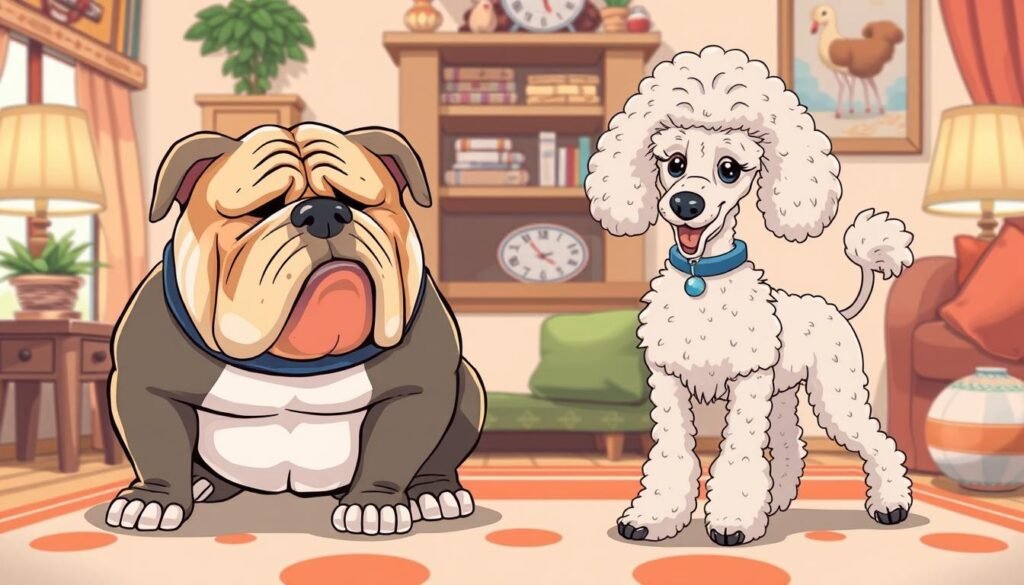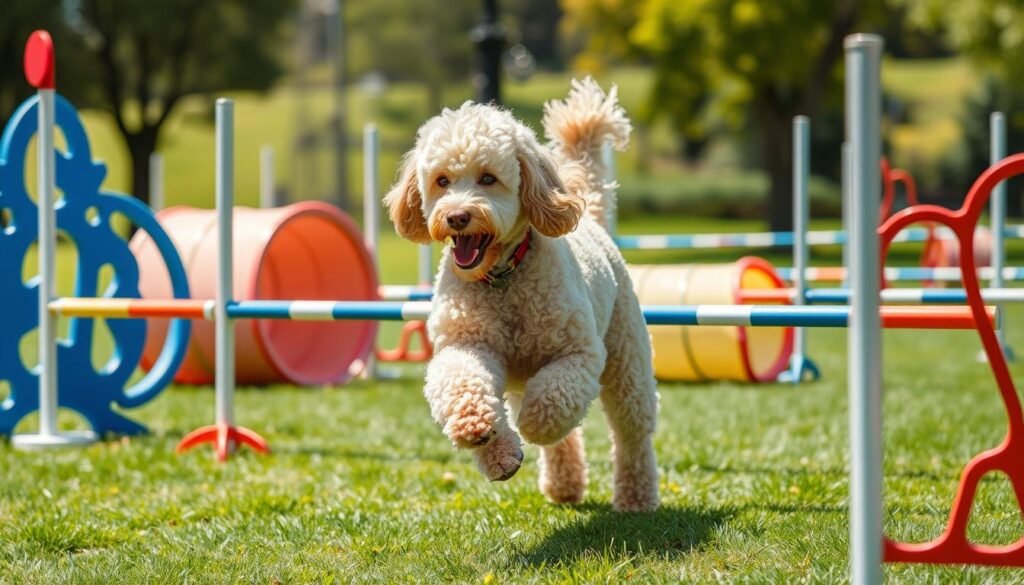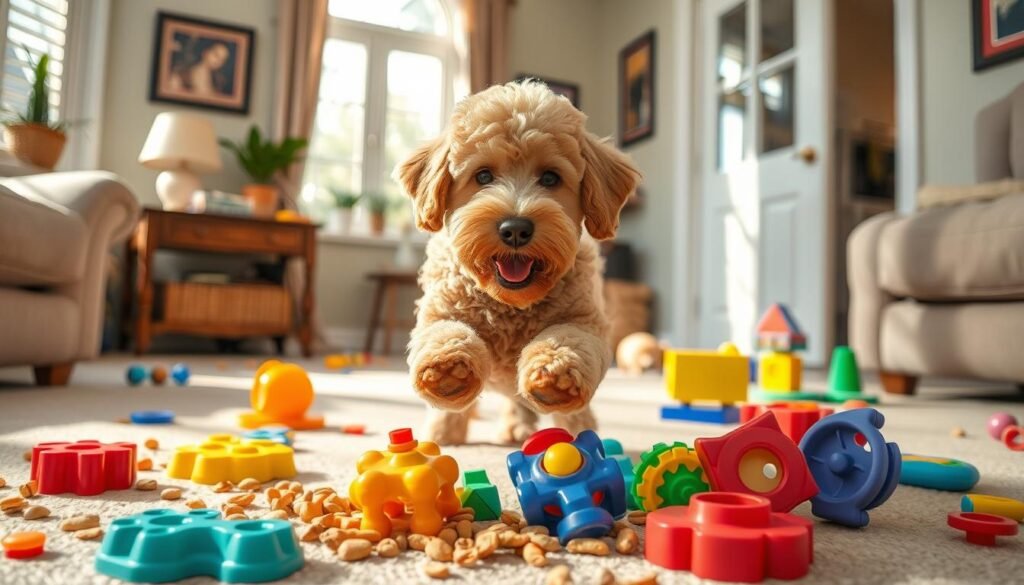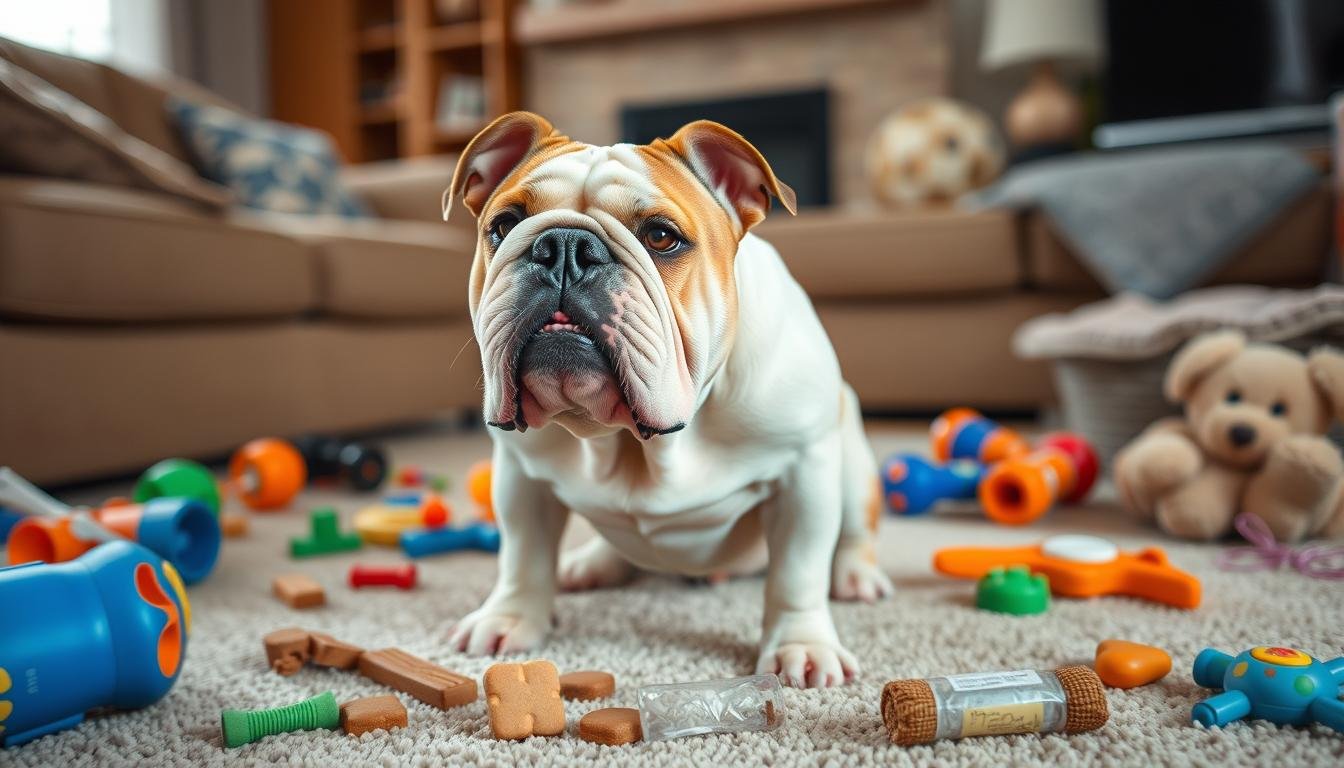Ever wondered why your Bulldog ignores your commands, or why your Poodle beats every training trick? You’re not alone. Dealing with breed-specific training challenges is like solving a puzzle. But, does understanding their breed traits unlock their potential?
Bulldog and Poodle training needs are as different as their looks. Bulldogs are tough-looking and sometimes seem aloof, making training tough. Poodles, however, are smart and full of energy, needing special training.
Starting your training journey? This guide will help you understand your Bulldog or Poodle’s unique nature. With the right approach, you can overcome training hurdles. Let’s explore how to tailor training for these special breeds.
Understanding Your Breed’s Unique Personality
Knowing your bulldog or poodle’s unique personality is key for good training and living together. Bulldogs and poodles have different traits. Understanding these differences helps you train and interact with them better.

Bulldogs are calm, courageous, and friendly. They seem stubborn or lazy at times, but it’s just their relaxed side. Poodles, on the other hand, are smart and active. They respond well to training if done right.
Both breeds have special behaviors. Bulldogs need a gentle, patient training style. They love loyalty and affection. Poodles do well in challenging environments that keep them thinking.
Adjusting your training to fit your pet’s personality makes training more effective. It also strengthens your bond. Remember, these breed-specific behaviors are key to understanding how your pet learns and reacts.
Physical Considerations in Training Bulldogs and Poodles
When training your Bulldog or Poodle, knowing their physical limits is key. Bulldogs face challenges due to their sturdy build and breathing issues. This makes some exercises hard for them.
Poodles, however, are agile and can do well in active training. Their athletic body is perfect for keeping them both fit and sharp.

It’s important to use adaptive training methods for each breed. Bulldogs need short, easy sessions to avoid exhaustion. Poodles, on the other hand, can handle longer, more varied training.
This tailored approach keeps both breeds healthy and happy. It also makes training more fun and engaging for them.
Bulldogs: Dealing with Respiratory Challenges
Training Bulldogs with respiratory issues needs careful thought. Their flat faces make breathing hard, especially during exercise. Knowing this helps ensure they can enjoy training without trouble.

Adjusting training is key when working with Bulldogs. Avoid long, hard workouts that worsen breathing problems. Short, frequent sessions are better. This keeps your Bulldog’s energy up without stressing their breathing.
Choose exercises that are good for your Bulldog’s health. Gentle walks, puzzle games, and light training are great. Make sure training areas are cool and have good air flow. Bulldogs can easily get too hot, which makes breathing harder.
Every Bulldog is different, so watch how they react to exercise. If they seem uncomfortable, stop right away. Talking to a vet who knows about Bulldog breathing issues can help. They can suggest a training plan that’s just right for your dog. Training that’s good for your Bulldog’s health means they can be happy and active.
Poodles: High Energy Levels and Mental Stimulation
As a Poodle owner, it’s key to manage their energy. This can change how you care for your pet. Poodles are smart and full of life. They need lots of chances to move and think.
Activities that challenge their minds and bodies are best. Try agility training or fetch. These activities help them solve problems and stay happy.
It’s not just about keeping them busy. It’s about making their activities meaningful. Teach them new tricks or use interactive toys. Puzzle feeders are great for keeping their minds sharp.
Balance is important. Make sure they get enough physical and mental challenges. This keeps them happy and healthy. It’s the secret to using their energy well and keeping your home peaceful.

Socialization Tips for Bulldogs and Poodles
Teaching dog social skills is vital for Bulldogs and Poodles. Each breed has its own needs. Knowing these can improve your Bulldog socialization strategies and Poodle interaction.
Start early. From puppyhood, introduce them to new things, people, and animals. This builds confidence and prevents anxiety or aggression.
Bulldogs are strong and sometimes shy. Socialization can make them less stubborn. Playdates, dog parks, and walks in busy areas are good. They learn to adapt and show their protective side.
Poodles love to engage and are very smart. They respond well to training. Activities like agility, games, and obedience training are great for them.
Be patient and consistent with both breeds. Every dog learns at their own speed. This helps in effective Bulldog socialization strategies and better Poodle interaction. The aim is to raise a happy, well-adjusted dog through positive training and exposure.
Training Bulldogs and Poodles at Different Life Stages
Starting a training journey with your Bulldog or Poodle means knowing about their life stages. Each stage has its own training opportunities and challenges. Using age-specific training methods can really help your dog learn better.
When your puppy is young, focus on basic commands and getting them used to new things. Puppies love trying new experiences, making it a great time to introduce them to people, pets, and places. Training at this age is all about making these new things positive for them.
As your Bulldog or Poodle grows up, training should focus on making learned behaviors stronger. This is also when hormonal changes start, which can affect their focus and behavior. It’s important to keep up discipline and socialization during this time.
When your dog reaches adulthood, you can start teaching them more complex things. Bulldogs and Poodles can learn advanced commands and even do jobs that fit their breed. Make sure to keep up with earlier training to keep them obedient and adaptable for life.
Senior dogs need special care in their training because they may not have as much energy or focus. Short, fun, and easy training sessions can help keep their minds sharp and bodies healthy. They need a slower pace in their training.
Knowing what your Bulldog or Poodle needs at each life stage can really help with training. Each stage requires a different approach to support their ongoing growth and learning.
Behavioral Issues Unique to Bulldogs and Poodles
When it comes to Bulldogs and Poodles, owners often face unique challenges. It’s important to find breed-specific solutions to ensure a well-behaved pet. Understanding Bulldog behavior and using Poodle correction techniques are key steps in nurturing a stable pet.
Bulldogs are known for their stubbornness. This trait often requires consistent and patient training. Using reward-based training can motivate Bulldogs to behave positively during training.
Poodles, on the other hand, are highly intelligent and sensitive. They can be anxious or over-excitable. Poodle correction should focus on calm training methods that build trust and confidence. This approach leverages their intelligence to learn complex commands.
It’s crucial to use tailor-fit strategies for each breed. For Bulldogs, short, engaging training sessions can prevent stubbornness. Poodles, meanwhile, benefit from mental stimulation through agility training or advanced obedience lessons.
Understanding and addressing these breed-specific behaviors makes training smoother. It also strengthens the bond between you and your pet. This leads to a harmonious and respectful relationship.
Bulldogs: Overcoming Stubbornness and Ingraining Obedience
If you’ve owned a Bulldog, you know about their stubbornness. This makes training a bit tricky. But, the right techniques can make training fun and rewarding. Using consistent commands is key for success with Bulldogs.
Consistency is your best friend when training a Bulldog. Using the same commands helps them learn faster. It clears up any confusion and tells them exactly what you want.
Training Bulldogs needs patience and persistence. Teach them basic commands like ‘sit’ and ‘stay’ slowly. A calm and firm approach helps them feel secure and more willing to listen.
Using the right rewards can also help a lot. Bulldogs love food, so treats work well. But, praise and affection are just as good. They build a strong bond and keep your Bulldog motivated and obedient.
Poodle Training: Harnessing Intelligence and Avoiding Boredom
Poodle intelligence is both a blessing and a challenge in training. Their sharp minds make them excel in engaging training sessions. These sessions teach them commands and help them solve problems.
To train your Poodle effectively, use puzzles and games. These activities match their cognitive abilities. This approach ensures they stay interested and learn well.
Boredom prevention is key when training a Poodle. These smart dogs get bored with simple or repetitive tasks. To keep them interested, add variety to their training.
Try new tricks and tasks often. This makes training sessions exciting and keeps them engaged. It also strengthens your bond with your Poodle.
Make your training sessions dynamic and versatile. Use interactive toys and outdoor adventures. These activities stimulate their intellect and prevent boredom. This method not only improves training but also deepens your connection with your Poodle.
Specialized Training Techniques for Bulldogs
Looking for bulldog training tips? It’s important to know the right methods for their unique personality. Bulldogs love positive reinforcement, where good actions get rewards. This makes training fun and effective for both you and your bulldog.
Begin with simple commands and stick to a regular training schedule. Positive reinforcement boosts your bulldog’s confidence and strengthens your bond. It’s especially helpful since bulldogs can be a bit stubborn.
Using treats, extra play, or praise can really get them to listen. Bulldogs are very food-driven, so treats work great as rewards. This makes training sessions successful.
Training a bulldog needs patience and consistency. By using these tips, you’ll make training smooth and effective. It’s all about meeting the needs of this special breed.
Essential Obedience Commands Every Poodle Should Know
Training your Poodle starts with learning the poodle obedience commands they need. Begin with basic training to lay a strong foundation. This will help your Poodle master more commands as they grow. Let’s explore some key commands and how to teach them for a well-behaved pet.
The first command is ‘sit’. It’s a basic command that helps with more complex ones. Hold a treat near your Poodle’s nose and slowly move it up. As they look up, they’ll sit down. Say “sit” and give them the treat and praise.
‘Stay’ is another important command. It’s useful when you need your Poodle to stay in one place. Start in a quiet area without distractions. Ask them to sit, then say “stay” and step back. Reward them for staying calm.
‘Come’ is key for recall and safety. Start in a controlled area with a leash. Say “come” while pulling gently on the leash. Reward them with treats and praise when they come to you. Gradually increase the distance and distractions.
The ‘heel’ command keeps your Poodle by your side. Start with them on a leash, walking beside you. Say “heel” and point to your side. Reward them for staying close. Consistency in commands and rewards is crucial for command mastery.
Remember, regular practice and patience are essential in Poodle training. With these poodle obedience commands, you’ll have a harmonious relationship with your well-trained Poodle.
Health and Nutrition’s Impact on Training Bulldogs and Poodles
When training your Bulldog or Poodle, remember the big role of canine health and nutrition. Their diet can greatly affect their learning. Knowing the Bulldog dietary needs and the Poodle nutrition impact is key.
Bulldogs need special diets because of their strong build. Too much weight can lead to joint pain and breathing problems. So, a diet that meets their Bulldog dietary needs helps their health and training.
Poodles are smart and full of energy. They do well on diets that support their brain and activity level. A diet rich in nutrients can make them better at learning and staying healthy.
Regular vet visits are also important. They make sure your dog is ready for training. A healthy dog learns better, making training easier.
Investing in your dog’s health through good nutrition really matters. It affects their behavior, training, and happiness. Giving your Bulldog or Poodle the right diet can make a big difference in their learning and performance.
Conclusion
In this guide, we explored the special needs of Bulldogs and Poodles. We learned that knowing your breed is key to successful dog training. Bulldogs need patience due to breathing issues and stubbornness. Poodles require constant mental stimulation because of their high intelligence and energy.
If you’re new to training Bulldogs and Poodles, or if you’ve been doing it for a while, this guide has something for you. It offers insights and techniques to improve your bond with your dog. By following these tips, you can create a more harmonious relationship with your pet.
When you face challenges, don’t be afraid to ask for help from professional trainers. They can offer specific advice that fits your dog’s unique traits. This approach will strengthen your bond and help your dog grow and learn.
Remember, training a dog is a long-term commitment. It requires consistency, persistence, and patience. With the knowledge from this guide, you’re ready to create a successful training environment. Be open to your dog’s needs, celebrate small victories, and always focus on raising a well-behaved and happy pet.
Your journey in dog training is filled with ups and downs. But with the right mindset and strategies, you can overcome any obstacle. Start your journey today, and watch your dog thrive.

